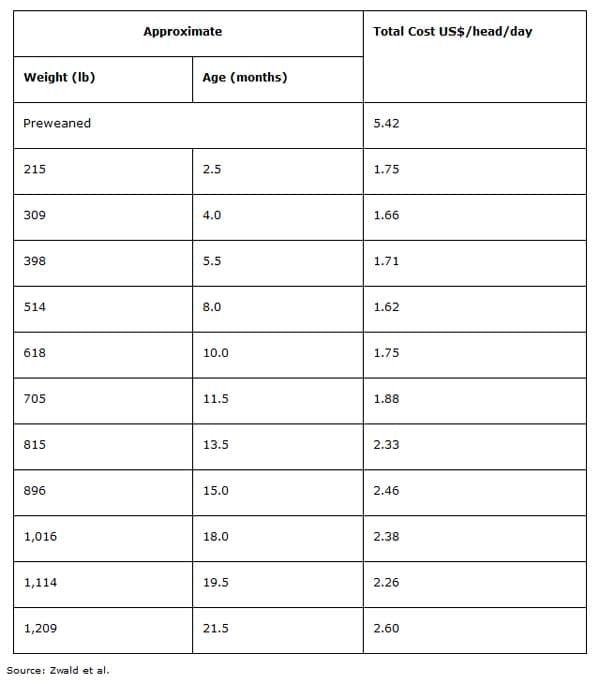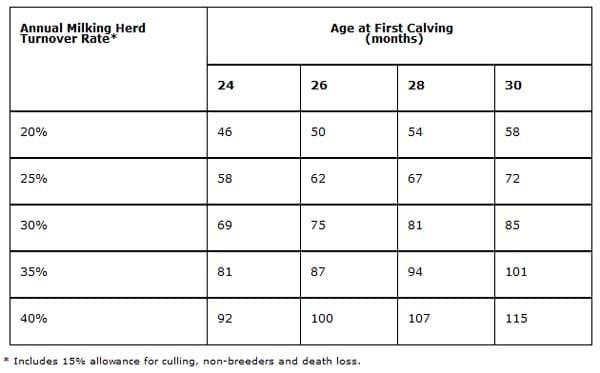The cost of raising replacement dairy heifers is significant. New studies show how much raising replacements can impact a dairy operation's bottom line.
Due to high herd-replacement rates and heifers calving at older ages, many operations need more heifers just to maintain the size of their milking herd.
The recently completed analysis of data from the 2010 Ontario Dairy Farm Accounting Project (ODFAP) survey puts the cost of raising a dairy heifer at $2,252, birth to calving. Led by the Dairy Farmers of Ontario (DFO), ODFAP collected data from 64 Ontario dairy farms.
Cash costs in this analysis totalled $1,483, with purchased feed and crop production costs making up the biggest share (Table 1). Feed costs do not include any value for colostrum or milk fed to the calf. The study uses crop production costs instead of directly valuing home-grown feeds.
Significant cash costs included repair expenses of $282 per heifer. Interest costs totalled $167.
Most producers can readily identify the cash costs of raising a heifer, but they often overlook overhead costs and the cost of their own time and management.
Depreciation of buildings and equipment used for heifers added $252 to the costs. The study reported 30.4 hours of unpaid labour and management to raise a heifer.
What is the value of unpaid farm labour and management time used to raise a heifer? At $17/hr, it adds $517, bringing the total cost of raising a heifer to $2,252.
Table 1. Heifer cost of production, Ontario, 2010
Costs were down about 10% from a similar Ontario analysis in 2007. The biggest reductions were interest costs, depreciation and unpaid labour. The unpaid labour was nearly 9 hours less in the 2010 study, although the reasons are not clear.
Some producers will value labour at a lower rate, while others may price it higher. At $12/hr, the total cost of raising a heifer would be $2,100. If the calculation had used the DFO rate of $26.60 for labour and management, the cost to raise a heifer would total $2,544.
Table 2. Comparison between herds with low age at first calving and herds with high age at first calving
The new Profit Profiler program developed by CanWest DHI has a unique way of looking at heifer costs. Profit Profiler calculations found that the cost of raising heifers averaged 11% of the milk revenues on dairy farms. Heifer costs ranged from 9% to 13% of milk revenue for the 25% and 75% percentile range groups.
Profit Profiler calculated the average annual cost to raise a heifer to be $900, excluding interest and depreciation. At the average calving age of 26.6 months, that works out to $2,000 plus interest and depreciation to raise a heifer to calving age.
Profit Profiler selected the 20 herds with the lowest age at first calving and the 20 herds with the highest age at first calving from the 85 herds in their 2009?2010 data (Table 2). Note that the herds using Profit Profiler are generally above the provincial average 305-day milk production.
The average age at first calving was 24.0 months for the low-age group and 28.2 months for the high-age group.
The two groups had similar average daily costs to raise a heifer, but the four-month difference in actual calving age resulted in the high-age group costing $300 more to reach calving.
The Profit Profiler study also found that the farms in the low-age group had higher milk production for the first lactation heifers and higher average herd milk shipments per cow, compared to the high-age group.
Table 3. Daily costs of raising one heifer in Wisconsin 2007
Varying Costs in different areas
Ontario cost numbers are similar to U.S. reports.
A 2007 University of Wisconsin report estimated the cost to raise a heifer in Wisconsin at US$1,649 ? an increase of 31% from 1998.
An analysis by Cornell University and Cornell Co-operative Extension in New York State in 2007 reported an average cost of US$1,734 to raise a heifer. This study analyzed 17 farms that had an average of 885 heifers.
One notable difference between the Ontario, New York and Wisconsin studies was the labour required to raise a heifer -18.2 and 21.3 hours per heifer, in New York and Wisconsin, respectively, and 35.1 hours per heifer in Ontario.
Why Ontario had significantly higher labour hours to raise a replacement than New York and Wisconsin is not clear. Two possible reasons are: 1) the New York and Wisconsin studies were based on larger enterprises than in Ontario, and 2) the heifers in Ontario had an average age at first calving of 27 months, while in the two U.S. reports, the average age at first calving was approximately 24 months.
The Wisconsin study estimated the daily cost to raise a heifer at various ages and weights (Table 3). As expected, pre-weaned calves were the most expensive, at US$5.42/day. After weaning, costs were US$1.60-US$1.80/day until 10 months of age. Then, daily costs slowly increased to US$2.60 at 21 months of age, as bred heifers approached freshening.
Table 4. Heifers required to supply replacements for a 100-cow herd
Impact of Heifer Costs
The number of animals needed to supply herd replacements can measurably impact total farm costs when the cost of raising a single heifer is considered. Table 4 projects herd replacement requirements, taking into account two factors: age at first calving and the milking herd's annual turnover percentage. The table includes a 15% allowance for culling, non-breeders and death loss.
Ontario herds enrolled in the Dairy Herd Improvement program currently average 26.6 months of age at first calving and have a 32% annual herd turnover rate.
The following examples show the impact of heifer costs. One herd has a lower-than-average age at first calving, while the other herd has a higher age at first calving and higher herd turnover percentage.
A 100-cow herd with a 30% herd turnover rate and a 24-month age at first calving would need 69 heifers on hand to supply adequate herd replacements. A second 100-cow herd, with a 40% herd turnover rate and a 28-month age at first calving, would need 107 heifers to meet replacement requirements.
The 38 extra heifers needed in the second herd would be a significant extra expense. The first herd could sell six extra heifers each year, further reducing net heifer expenses. The second herd would have to buy five each year to maintain enough replacements.
Conclusion
Heifers represent an important investment in your dairy farm's future. As with all investments, however, looking at costs as well as returns could pay dividends for your bottom line.
References
Karszes, J., C. Wickswat and F. Vokey. 2008. Dairy Replacement Programs: Costs & Analysis December 2007. Cornell University.
Zwald, A., T.L. Kohlman, S.L. Gunderson, P.C. Hoffman and T. Kriegl.2007. Economic Costs and Labor Efficiencies Associated with Raising Dairy Herd Replacements on Wisconsin Dairy Farms and Custom Heifer Raising Operations. University of Wisconsin
This article was originally published in The Ontario Ministry of Agriculture, Food and Rural Affairs (OMAFRA) website, http://www.omafra.gov.on.ca, December 2011, Last reviewed July 2012. Engormix.com thanks for this huge contribution.














.jpg&w=3840&q=75)